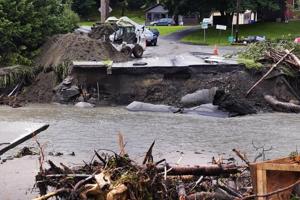BOSTON (AP) — The latest flooding in Vermont has added fresh urgency to concerns about the hundreds of dams in the state, a third of which are more than a century old. This week’s deluge from the remnants of Hurricane Beryl wasn’t as bad for the hundreds of dams compared to last year’s floods, when five failed and nearly 60 overtopped. But the second bad flood in a year raises concerns about the viability of these structures as climate change brings heavier rains and more powerful storms.
“The many thousands of obsolete dams that remain in our rivers do not provide protection from flooding, despite what many may think,” Andrew Fisk, the northeast regional director for the environmental advocacy group American Rivers, said. “Dams not created specifically for flood protection are regularly full and do not provide storage capacity. And they also frequently direct water outside of the main channel at high velocities which causes bank erosion and impacts to communities.

” The challenge facing dams in Vermont is as more dams overtop or fail during heavy rains. The Rapidan Dam, a 1910 hydroelectric dam in Minnesota, was by the second-worst flood in its history. And in Texas, flooding damaged the Lake Livingston Dam’s spillway about 65 miles (105 kilometers) northeast of Houston.
There are roughly 90,000 significant dams in the U.S. At least 4,000 are in poor or unsatisfactory condition and could kill people or only harm the environment if they failed, according to d.























